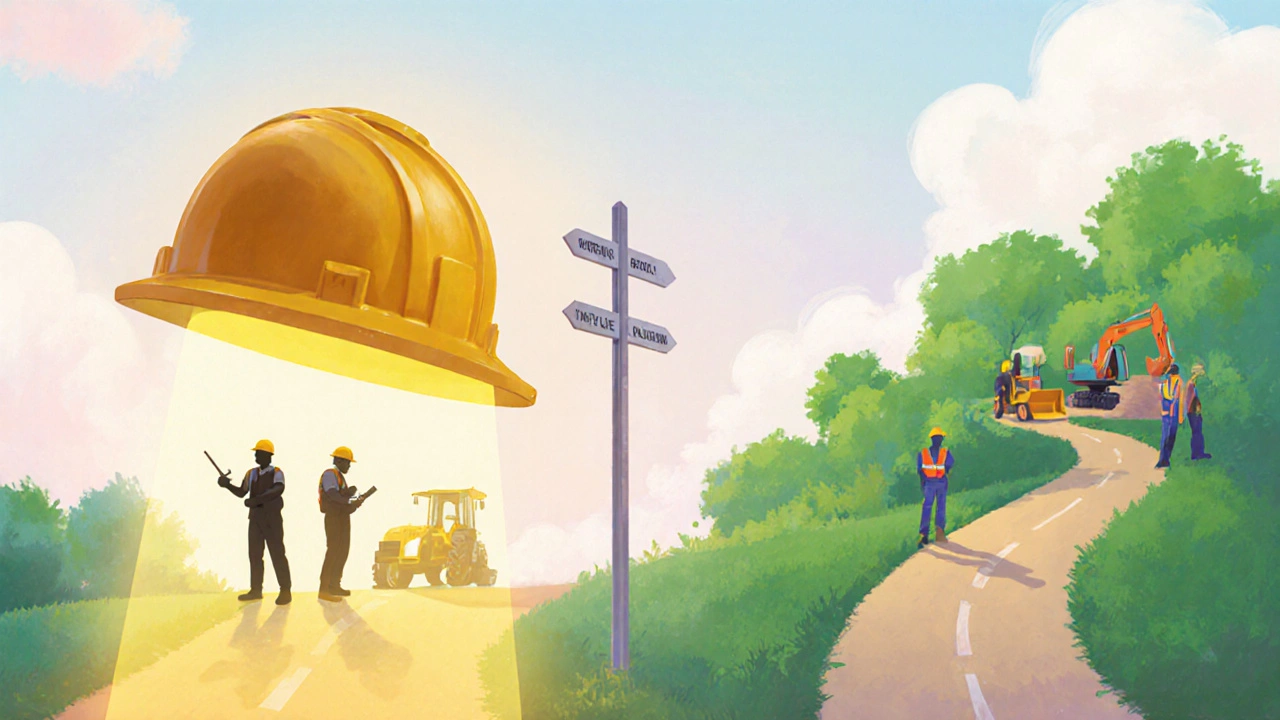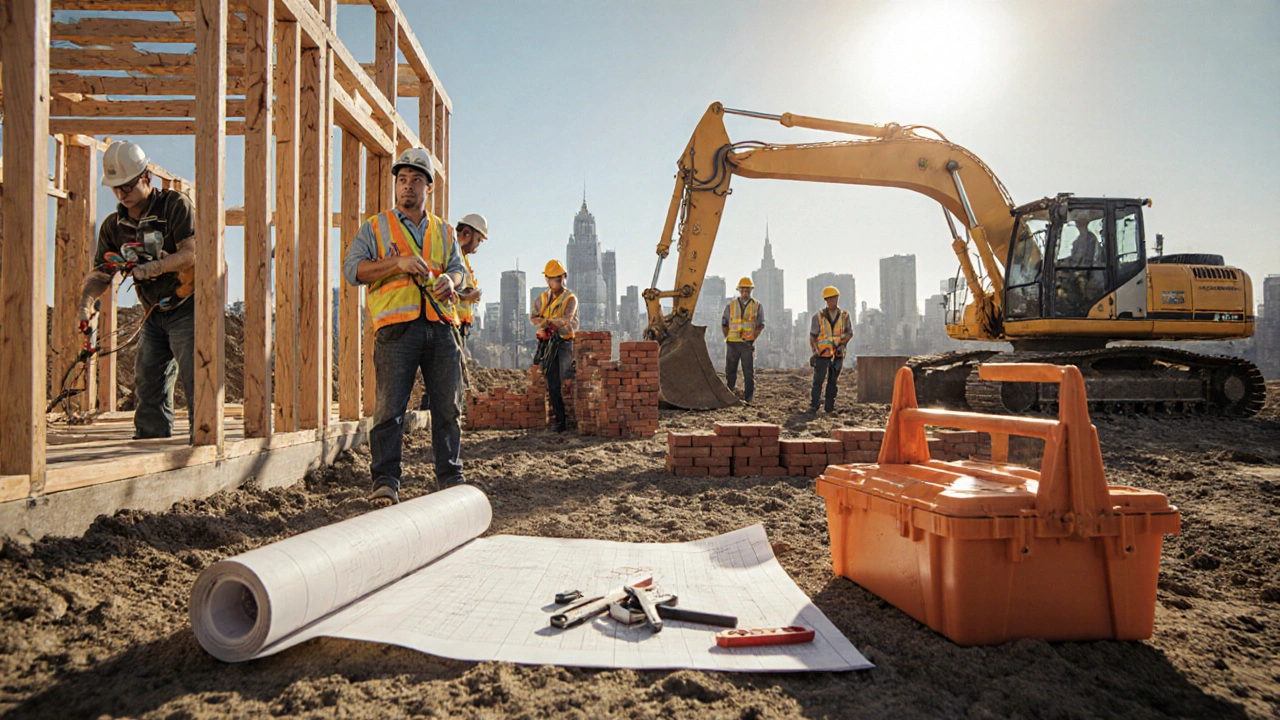Construction Trade Evaluator
Your Preferences
Scoring Guide
Rate each trade from 1 (lowest) to 5 (highest) for:
- Salary - Average annual income
- Growth - Projected job growth (2025-2030)
- Training - Length of apprenticeship
- Lifestyle - Work-life balance fit
Trade Ratings
| Trade | Salary (NZ$) |
Growth (2025-2030) |
Training (Years) |
Work Type | Salary (1-5) |
Growth (1-5) |
Training (1-5) |
Lifestyle (1-5) |
Total (Max 20) |
|---|---|---|---|---|---|---|---|---|---|
| Carpentry | 68,000 | 8% | 3-4 | Mixed | - | ||||
| Electrical Work | 85,000 | 10% | 3-4 | Indoor/Site | - | ||||
| Plumbing | 78,000 | 9% | 3-4 | Indoor/Site | - | ||||
| Tiling | 65,000 | 6% | 2-3 | Indoor | - | ||||
| Bricklaying | 70,000 | 7% | 3-4 | Outdoor | - | ||||
| Heavy-Equipment Operation | 90,000 | 12% | 2-3 | Outdoor | - |
Results Summary
Key Takeaways
- Carpentry, electrical work, and plumbing are the top‑earning trades in NZ for 2025‑2030.
- Training length ranges from 2‑4 years, with apprenticeships offering paid on‑the‑job learning.
- Job growth is strongest for heavy‑equipment operation and electrical work, driven by housing demand and green‑building projects.
- Match your lifestyle preferences (outdoors vs. indoors, team vs. solo) with the trade’s typical work environment.
- Use the comparison table below to line‑up salary, growth, and training before you decide.
If you're hunting for the best trade in construction, you’ve come to the right place. Whether you’re fresh out of school, switching careers, or advising a friend, the goal is the same: find a trade that pays well, offers steady work, and fits your personality.
When you hear the term construction trade is a skilled occupation that focuses on a specific portion of a building project, such as framing, wiring, or pipe fitting, it signals a career path that combines hands‑on work with steady demand. In NewZealand, the construction sector contributes roughly 7% of GDP and is expected to add more than 30000 jobs by 2030. That growth creates a real need for qualified tradespeople.
What Makes a Trade "Best"?
There’s no single formula, but most professionals rank four factors:
- Earning potential - average annual income and overtime opportunities.
- Job security - how quickly vacancies fill and projected growth.
- Training pathway - length, cost, and whether you can earn while you learn.
- Work‑life fit - typical hours, physical demands, and work environment.
By scoring each trade against these criteria, you can objectively see which one lines up with your goals.
Top Construction Trades in NewZealand (2025)
Below are the six trades that consistently rank highest across the four factors. The first three also appear in the NZ Government’s Skills Shortage List for 2025‑2028.
Carpentry is the art of shaping wood and building structural frames for residential and commercial projects. Carpenters earn an average NZ$68,000 per year and enjoy a blend of indoor and outdoor work.
Electrical work is the installation, maintenance, and testing of wiring systems, lighting, and power distribution. With the rise of solar installations and smart homes, electricians can pull in up to NZ$85,000 annually.
Plumbing is the design and fitting of water supply, drainage, and heating systems in buildings. Plumbers often command NZ$75,000‑$80,000 salaries and see strong demand in both new builds and retrofits.
Tiling is the precise placement of ceramic, porcelain, or stone tiles on floors, walls, and wet areas. While the average salary sits around NZ$65,000, specialist tilers can earn more on high‑end residential projects.
Bricklaying is the construction of walls, façades, and structural elements using bricks, blocks, or concrete masonry units. Bricklayers earn about NZ$70,000 and are indispensable in multi‑storey developments.
Heavy‑equipment operation is the piloting of cranes, excavators, and loaders on construction sites. Operators command high hourly rates (NZ$30‑$45) and see a 12% growth projection due to infrastructure spending.
How to Evaluate a Trade: A Simple Scoring Sheet
Grab a notebook or spreadsheet and give each trade a score from 1 (low) to 5 (high) for the four criteria listed above. Add the numbers for a total out of 20; the highest totals usually point to the best fit.
- Salary - use the figures from the table below.
- Growth - refer to the projected vacancy rate from the Ministry of Business, Innovation & Employment (MBIE).
- Training length - apprenticeship plus any NZ Certificate level.
- Lifestyle - consider physical strain, typical hours, and indoor vs. outdoor work.

Side‑by‑Side Trade Comparison
| Trade | Average Salary (NZ$) | Projected Growth 2025‑2030 | Apprenticeship Length | Typical Work Setting |
|---|---|---|---|---|
| Carpentry | 68,000 | 8% | 3‑4years | Mixed indoor/outdoor |
| Electrical work | 85,000 | 10% | 3‑4years | Indoor & site labs |
| Plumbing | 78,000 | 9% | 3‑4years | Indoor & site |
| Tiling | 65,000 | 6% | 2‑3years | Indoor, residential |
| Bricklaying | 70,000 | 7% | 3‑4years | Outdoor, commercial |
| Heavy‑equipment operation | 90,000(annualized) | 12% | 2‑3years | Outdoor, site‑focused |
Choosing the Right Trade for You
Answer these quick questions to narrow the field:
- Do you prefer working hands‑on with a tool (carpentry, tiling) or with complex systems (electrical, plumbing)?
- Are you comfortable with heights and operating large machines? If yes, heavy‑equipment might be a fit.
- Do you enjoy indoor environments and precise measurements? Tiling and electrical work often stay inside.
- How much time can you devote to training? Shorter apprenticeships (2‑3years) get you earning sooner.
- What lifestyle do you envision? Trades with frequent overtime (electrician, heavy‑equipment) can boost earnings but impact personal time.
Match your answers with the trade profiles above. For example, if you love working outdoors, see a house being built from foundation to roof, and enjoy a blend of physical work and craft, carpentry or bricklaying could be the sweet spot.
Path to Qualification: From Apprentice to Certified Pro
The most reliable route is an apprenticeship backed by an NZ Certificate (Level4 or 5). Here’s a typical timeline:
- Find an employer - use the NZ Apprenticeship Hub, trade unions, or local construction firms.
- Enroll in a registered training organization (RTO) - they provide the classroom theory that counts toward your certificate.
- On‑the‑job learning - you’ll earn 80‑90% of a journeyman’s wage while you work under a qualified mentor.
- Complete competency assessments - at the end of each stage, an assessor verifies you can perform tasks safely and to code.
- Get your NZ Certificate - this formal credential unlocks higher‑pay roles and can be transferred across the country.
Most apprentices earn between NZ$25,000 and NZ$40,000 in the first year, and the salary climbs sharply once you achieve journeyman status.
Common Pitfalls and How to Avoid Them
- Choosing a trade based solely on hype - research real salary data and vacancy rates before committing.
- Skipping the apprenticeship - short‑course certificates look good on paper but lack the practical experience employers demand.
- Ignoring health and safety training - trades involve heavy lifting, heights, and electrical hazards; proper certification protects you and your future jobs.
- Not networking - join trade unions, attend industry expos, and keep in touch with mentors; many jobs are filled through word‑of‑mouth.
Next Steps: Your Action Plan
- Pick two trades that score highest on your personal criteria.
- Visit the NewZealand Apprenticeship Hub and filter listings by those trades.
- Contact at least three employers for informational interviews - ask about day‑to‑day tasks and progression.
- Enroll in a short‑term intro course (often free) to see if the work feels right.
- Apply for an apprenticeship; prepare a simple CV highlighting any construction‑related volunteer or DIY projects.
Following these steps will get you on the road to a rewarding, well‑paid construction career.

Frequently Asked Questions
Which trade offers the highest starting salary in NZ?
Electricians typically start around NZ$55,000‑$60,000, edging out other trades because of the technical expertise and safety certifications required.
Do I need a secondary school qualification to start an apprenticeship?
A NCEA Level2 or equivalent is usually enough, but many employers prefer Level3. Some RTOs also accept mature students who can demonstrate basic literacy and numeracy.
How long does it take to become a fully qualified plumber?
A full qualification typically requires a 3‑year apprenticeship plus the NZ Certificate in Plumbing (Level5). Some regional boards allow a fast‑track route that shortens the apprenticeship to 2years if you already hold a relevant certificate.
Is heavy‑equipment operation a physically demanding job?
It can be; you need good hand‑eye coordination, decent core strength, and the ability to work long hours in noisy, outdoor conditions. However, modern cabins are ergonomically designed, and most operators work in rotating shifts rather than continuous eight‑hour stretches.
What are the licensing requirements for electricians?
After completing an apprenticeship, you must pass the Electrical Workers Registration Board (EWRB) assessment and obtain a Class2 or Class3 licence, depending on the type of work you’ll do. Ongoing CPD (continuing professional development) is mandatory to keep the licence active.

Written by Fletcher Abernathy
View all posts by: Fletcher Abernathy